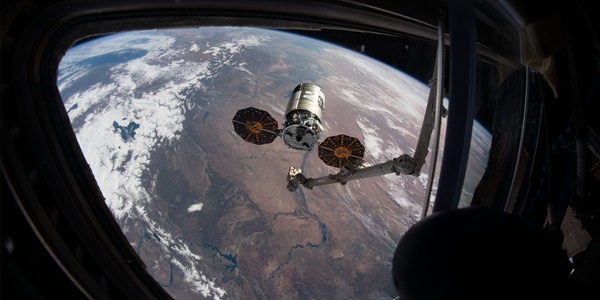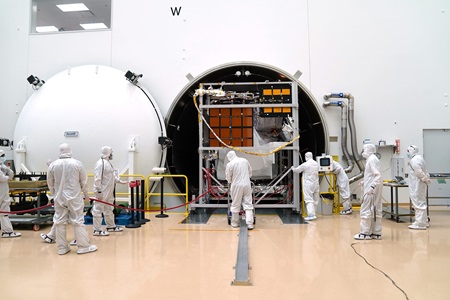Water on Mars

By Doug Bonderud
The search for water on Mars has captivated scientists and citizens alike — but it took a two-decade-old deployable designed for subsurface data gathering to start unmasking liquid Martian H20.
In 2000, a small team of engineers and technicians that are now part of the Northrop Grumman Deployables Operating Unit, faced a doubly difficult challenge: develop a 40-meter long antenna powerful enough to survey beneath the surface of Mars but small enough to fit on the European Space Agency's (ESA) Mars Express mission craft.
In 2018, the team’s innovative antenna idea helped to learn more about the presence of water on Mars.

Pioneering Technology for Space Deployable Structures
While space deployable structures are now commonplace in interplanetary exploration, the Mars Advanced Radar for Subsurface and Ionosphere Sounding (MARSIS) antenna team pioneered the technology for this mission.
Geoff Marks, lead technologist for MARSIS recalled, "Our customer provided us with the required thickness and length of the radar antenna, then asked us to come up with an idea for how to fit it in the spacecraft, then deploy it in space."
Because the antenna was built for a low-frequency radar, it had to be 40 meters long once fully deployed in orbit. The problem? It needed to be around 1.5 meters in length while in transit and able fit on the side of a spacecraft the size of a subcompact car.
Fortunately, the team had some arrows in their deployables quiver. Since 1958, Astro Aerospace had been pioneering the technology of space-deployable structures — devices that can be dramatically reconfigured once in space.
For MARSIS, the team designed a lightweight space deployable dipole antenna using two 20-meter booms or poles, which collected information by sending radar pulses to Mars' surface and receiving pulses in return. A third, shorter boom eliminated interference between real signals and possible scatter, acting like a massive set of rabbit ears on old television sets.
The most innovative aspect of the design was a new concept created by Marks, called foldable-flattenable-tube (FFT) booms, which enabled the antennas to achieve full stow shrinkage. FFT booms are like the cardboard tubing inside paper towel rolls: long, light and thin-walled. This allows them to support the full length of the antenna's electrical elements and — with some ingenious engineering — fold.
From Deployable Concept to Deliverable Reality
In just a few years, Astro Aerospace's passionate problem solvers delivered a first-of-its-kind space deployable antenna. "The technicians and the engineers both brought different sides of the equation to execute the hardware," says Michael Beers, the structural engineer for MARSIS. "You need a diversity of skills and backgrounds to bring a product from concept to execution."
The team took advantage of computer simulation tools to successfully test components of MARSIS — an important step since Earth's gravity makes it physically difficult to test fully constructed deployable space hardware. As Bob Chang at Northrop Grumman noted, "On Earth, the antenna doesn't pop straight out like it does in space, so these mock demonstrations are key to building our confidence in the success of the mission."

Supporting Mars’ Deep Surface Discovery Missions
In 2004, the MARSIS antenna was deployed and allowed Mars Express to collect and deliver data, and pave the way for learning more about whether water on Mars exists in a liquid form.
Powered by Northrop Grumman's LN-200S navigator, NASA's exploration of Mars' mysteries continues with the Perseverance Rover, which landed on Mars on February 18, 2021. For one Mars year — about 687 Earth days — the rover will collect information to further our understanding of Mars.
While new discoveries on Mars are often several years — or for the MARSIS antenna, over a decade — in the making, this has never deterred the passionate scientists and researchers on the cutting edge of space exploration and technology innovation.
More Innovation Stories
Read all stories about advanced technology and innovation >>


